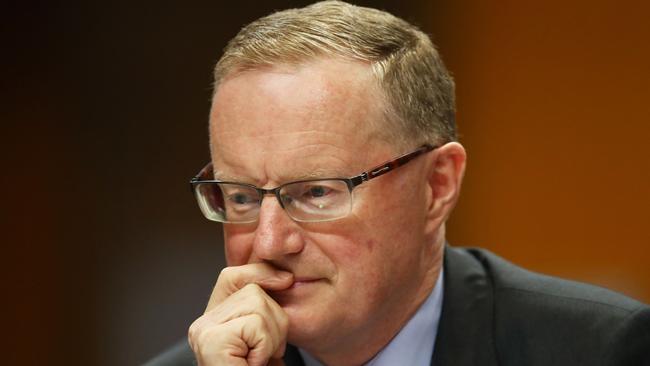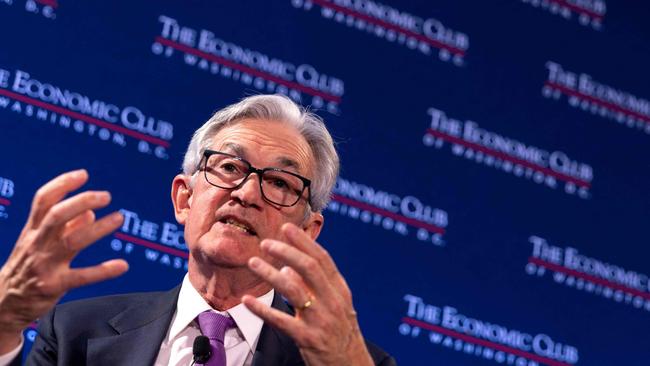
And the Albanese government will not like the message that is revealed via the broken code. By matching the events in both the US and Australia, we can now better understand why Reserve Bank governor Philip Lowe moved from his December view when he was looking to heed the Commonwealth Bank’s warnings about the community and economic impact of much higher interest rates.
Now he plans to ignore those warnings, and it looks like both the RBA and Federal Reserve are set to use sledgehammers to crack the inflation nut. This is not what markets are predicting, although Wall Street fell after Powell’s code breaking speech.

In my view, Lowe will not want to leave a high inflation legacy and, given that Jim Chalmers has declared he will “renovate” the RBA, Lowe must know that replacing him is likely to be part of that “renovation”. Meanwhile, as I set out below, the CBA is issuing dire warnings about what happens if interest rates are lifted in the way the market anticipates.
Using the Powell code breaker, we discover that both central banks are surprised that, despite the interest rate rises, that consumer spending rate remains strong. In Australia, that strong consumer spending has continued in January. In the US, the prices of goods are coming down. In Australia, there is not much sign of falls at this stage.
But then a decoded Powell says that a goods price fall is not enough to stop further increases in interest rates because inflation and a shortage of labour have boosted American wage levels, which means that the reduction in prices could only be temporary.
Therefore, before reducing rates, Powell needs to see the labour market and wage rises have returned to a level that can safeguard an inflation rate of around 2 per cent.
Here in Australia, our inflation, although at similar levels to the US, has not penetrated the wages system to anywhere near the same degree.

But led by Employment Minister Tony Burke and supported by Prime Minister Anthony Albanese, the current government is doing everything in its power to follow the US and boost wages. Given the shortage of labour and the reduction in real wage incomes, it looks like they will succeed.
That means that the forecasts of another set of big interest rate rises look to be accurate. The only thing standing between those rate rises and moderation is that warning of the CBA as to the consequences of following the US interest rate sledgehammer.
The CBA says the looming conversion of the large numbers of low rate fixed rate mortgages to the current interest rates will result in a “massive step change in the size of mortgage repayments”.
“The upshot is that a significant amount of tightening lays ahead, irrespective of how much higher the RBA takes the cash rate.
“But the (Reserve Bank) board appears to have shelved the notion of pausing soon and more policy tightening lays ahead
“We think that the RBA is underestimating the lagged impact that the already delivered interest rate hikes will have on the economy in 2023.
“It takes time for rate hikes to impact home borrower cash flow and by extension spending decisions”
The bank says unemployment will rise.
Both the Australian and American share markets believe we can counter inflation without creating the severe downturn that CBA bank is predicting. And that view is backed by those retailers that are enjoying current strong consumer spending

Somebody is going to be wrong. But clearly we are entering a world where both the US and Australia are headed into dangerous territory.
But for Australia we are going to be helped by the fact that China which does not have an inflationary problem is now set for much higher levels of economic activity. This does not convert to the boost to Australia that occurred after the global financial crisis because iron ore gas and coal prices are already strong.
But it will help Australia through tourism and education.
In addition, as I revealed last week the Australian government is set to have a surplus in 2022-23 and the treasurer appears to be winning in his fight to restrain the big spenders in the cabinet.
We will discover in the budget in May whether Chalmers was successful, but a government that is restraining expenditure is taking some of the anti inflation burden away from the RBA and interest rates.
But of course those efforts are being offset by the Burke factor.
In the US, there is a similar situation. The Federal Reserve’s anti-inflation policy conflicts with the government’s attempt to boost plant investment with major outlays in an attempt to reduce future production costs. But that expenditure boosts economic activity and wage levels, which is one of the contributing factors to the US wage problem.







Australia and the US have both remarkably similar inflationary problems and central bankers who speak in code. Federal Reserve chair Jerome Powell this week helped us break some of the code to better understand what is ahead for Australia.